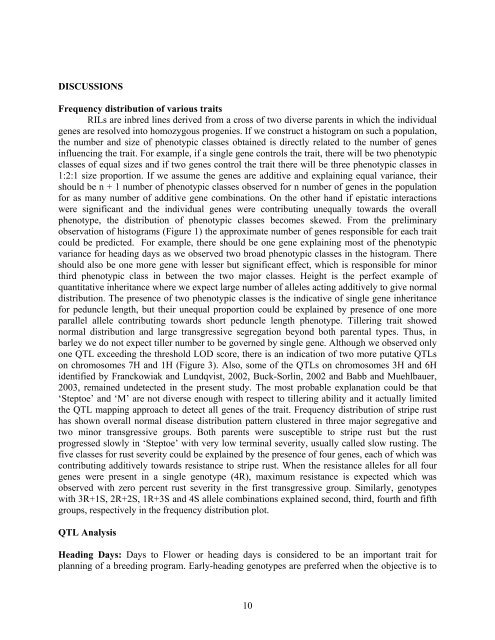BARLEY GENETICS NEWSLETTER - GrainGenes - US Department ...
BARLEY GENETICS NEWSLETTER - GrainGenes - US Department ...
BARLEY GENETICS NEWSLETTER - GrainGenes - US Department ...
You also want an ePaper? Increase the reach of your titles
YUMPU automatically turns print PDFs into web optimized ePapers that Google loves.
DISC<strong>US</strong>SIONS<br />
Frequency distribution of various traits<br />
RILs are inbred lines derived from a cross of two diverse parents in which the individual<br />
genes are resolved into homozygous progenies. If we construct a histogram on such a population,<br />
the number and size of phenotypic classes obtained is directly related to the number of genes<br />
influencing the trait. For example, if a single gene controls the trait, there will be two phenotypic<br />
classes of equal sizes and if two genes control the trait there will be three phenotypic classes in<br />
1:2:1 size proportion. If we assume the genes are additive and explaining equal variance, their<br />
should be n + 1 number of phenotypic classes observed for n number of genes in the population<br />
for as many number of additive gene combinations. On the other hand if epistatic interactions<br />
were significant and the individual genes were contributing unequally towards the overall<br />
phenotype, the distribution of phenotypic classes becomes skewed. From the preliminary<br />
observation of histograms (Figure 1) the approximate number of genes responsible for each trait<br />
could be predicted. For example, there should be one gene explaining most of the phenotypic<br />
variance for heading days as we observed two broad phenotypic classes in the histogram. There<br />
should also be one more gene with lesser but significant effect, which is responsible for minor<br />
third phenotypic class in between the two major classes. Height is the perfect example of<br />
quantitative inheritance where we expect large number of alleles acting additively to give normal<br />
distribution. The presence of two phenotypic classes is the indicative of single gene inheritance<br />
for peduncle length, but their unequal proportion could be explained by presence of one more<br />
parallel allele contributing towards short peduncle length phenotype. Tillering trait showed<br />
normal distribution and large transgressive segregation beyond both parental types. Thus, in<br />
barley we do not expect tiller number to be governed by single gene. Although we observed only<br />
one QTL exceeding the threshold LOD score, there is an indication of two more putative QTLs<br />
on chromosomes 7H and 1H (Figure 3). Also, some of the QTLs on chromosomes 3H and 6H<br />
identified by Franckowiak and Lundqvist, 2002, Buck-Sorlin, 2002 and Babb and Muehlbauer,<br />
2003, remained undetected in the present study. The most probable explanation could be that<br />
‘Steptoe’ and ‘M’ are not diverse enough with respect to tillering ability and it actually limited<br />
the QTL mapping approach to detect all genes of the trait. Frequency distribution of stripe rust<br />
has shown overall normal disease distribution pattern clustered in three major segregative and<br />
two minor transgressive groups. Both parents were susceptible to stripe rust but the rust<br />
progressed slowly in ‘Steptoe’ with very low terminal severity, usually called slow rusting. The<br />
five classes for rust severity could be explained by the presence of four genes, each of which was<br />
contributing additively towards resistance to stripe rust. When the resistance alleles for all four<br />
genes were present in a single genotype (4R), maximum resistance is expected which was<br />
observed with zero percent rust severity in the first transgressive group. Similarly, genotypes<br />
with 3R+1S, 2R+2S, 1R+3S and 4S allele combinations explained second, third, fourth and fifth<br />
groups, respectively in the frequency distribution plot.<br />
QTL Analysis<br />
Heading Days: Days to Flower or heading days is considered to be an important trait for<br />
planning of a breeding program. Early-heading genotypes are preferred when the objective is to<br />
10




